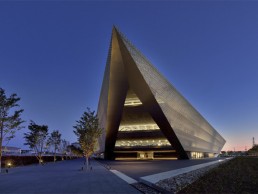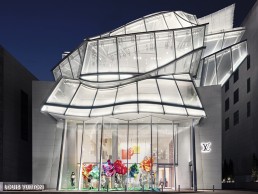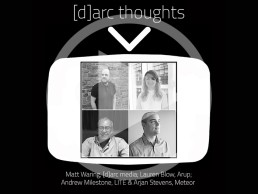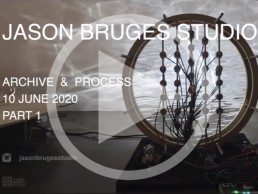Otemon Academic Ark, Japan
The Otemon Gakuin University’s newest campus opened a year ago in the heart of Smart-City Ibkaraki in northern Osaka, Japan. The 40,000sqm facility is home to half of the university’s student population, equating to roughly 3,600 students.
Designed by architectural firm Mitsubishi Jisho Sekkei with lighting design from akari+DESIGN, the striking triangular structure presents a beautiful learning facility for the students.
Project Architect Yasuhiro Sube sat down with arc to discuss the project: “I wanted to design a one-building campus that would encourage communication in the age of texting and smartphones. My inspiration was the image of an iconic inverted triangular pyramid floating over the Earth,” he explained.
“An analysis of the surrounding urban landscape led me to conclude that a triangular plan was most appropriate for the site, and this developed into an inverted pyramid form, a powerful contemporary shape that attracts students and community members. I used environmental simulation software to further refine the form through computational design.”
In an age of internet technology increasing the ability to communicate remotely, the architects were driven to create an educational complex that would draw students in, stimulate their interests and encourage exploration.
Taking inspiration from traditional Japanese shrines, the architects created the dubbed Academic Ark as a place of gathering, much like that of a shrine that attracted pilgrims from across the country to meet. The Academic Ark’s outstanding triangular form presents steeply angled sides that create an inviting “gate” that students and educators enter through. Inside the Ark, audiences are welcomed with a great floating silver volume in the main hall. The floating volume contains a library filled with books and a book trail that encircles the centrepiece, which is flanked by six large classrooms on both the second and third floors. Above, 21 classrooms fill the fourth and fifth floors. “A large void between the library and the book trail allows for visibility between the floors, making apparent the energy created by a learning site where individuals both see and are seen by each other,” explained the firm.
Lighting design, by Hiroyasu Yoshino and Mai Okada at akari+DESIGN, was integrated in the early stages of design in a close working relationship with the architects. “I contacted Mr [Hiroyasu] Yoshino at quite an early stage in the project, once I’d decided on an inverted pyramid form with a floating library inside,” explained Sube. “I wanted the lighting to strengthen the impact of the design, so that the structure and space would really stay with people. Mr Yoshino and I have collaborated on other projects, and I love the way his lighting design is modulated to create a mysterious atmosphere, similar to the light of the sun and moon.
“Mr Yoshino’s lighting is as essential to my spaces as the sun and moon. The most striking space is useless in the dark. His lighting is an art, with the power to give life and emotional impact to architecture, differentiating it from ordinary environments.”
Speaking of his collaboration with Yoshino, Sube added: “I tell him about the space I am envisioning and the points that require special attention from the perspective of user convenience and leave the rest to him. Satoko Uda, Mitsubishi’s electrical engineer, also collaborates with Mr Yoshino not only on the engineering but also on issues related to post-construction management and operation.”
When discussing the design details for the floating library, Sube describes how the working relationship with Yoshino influences his architectural choices. “We jointly came up with the idea of using reflective material from the K-Spot spotlights designed by Shiro Kuramata, whose work we both love,” he said. “I’d been wanting to use that material in an architecture project, but there weren’t any previous examples of it being applied in such a large space. The way we worked with contractors and construction workers unfamiliar with this industrial item was through trial and error to create a huge, seamless floating mass, made a strong impression on me.”
Inside the Academic Ark, the modern architecture is enhanced with the use of architectural lighting, which defines the lines and textures of the building.
“My brief was to attractively illuminate this unique triangular architectural form,” explained Yoshino. “I was also asked to design artistic, centripetal interior lighting, and exterior lighting that would make the structure into a reassuring local landmark. These fundamental concepts remained consistent from start to finish.”
Yoshino claims his initial impressions of the triangular structure, both inside and out, were like that of a spaceship. “I wanted to somehow use light to make this silver form float in the air,” he explained. “I was also thinking about maintenance and using indirect lighting in a way that creates a physical sensation. All of the interior spaces are lit with long, thin dotless LED lights. These thin lines of light emphasise the edges of the triangles, creating a futuristic impression. In particular, the 15mm-wide linear LEDs on the outside of the corridor handrails both effectively bring out the library’s exterior walls and contribute ambient light to the entire atrium through reflection.”
Inside the library space, Yoshino encountered one of the inevitable challenges a project like this brings. One of the structural constraints he faced was with the library bookshelves. “At first, I intended to install horizontal LEDs on the shelves, but I then learned that the lights could not be attached there, so I hastily switched to vertical linear LEDs on the boards forming the sides of the shelves so that the bookshelves themselves function as lighting,” he explained. “Switching to a vertical design had the added effect of emphasising the height of the shelves and making the space more striking, so the design ended up evolving thanks to on-site problem solving.”
Yoshino’s lighting scheme was so successful due to the attention to detail he carried throughout the building and to the student’s wellbeing when using the space. One example of this is seen in the embedded LEDs in the handrails illuminating the exterior of the library in the atrium. He explained further: “These linear dotless LEDs are controlled with a DMX signal, which dims them in a slow, random pattern. I felt that the light needed to flicker in this way because there are no skylights or other source of natural light in this space. When students leave the classrooms, they experience a sense of passing time arising from this flickering light, which is similar to slowly passing clouds.”
Along with the health and wellbeing of the student’s playing a big part both the architectural and the lighting designs, the architecture was also sensitive to its environmental impacts. As Sube explained: “The façade is fabricated from unpainted cast stainless steel, treated to prevent dulling and shaped like cherry blossom petals - the first example of its kind in the world. This “eco-screen” reduces thermal load by 50% and blocks visibility from the surrounding residential neighbourhood, so that those inside and outside the building are not aware of one another.
“In Japan, when the cherry blossom trees are in full bloom, groups of friends gather under them to eat and drink. I wanted to create a place for learning that was surrounded by this same motif of cherry blossoms in full bloom. For the past 10 years or so, I have been interested in the potential of cast metals to reduce environmental load by lowering the amount of solar heat that buildings absorb. Cast aluminium must be painted but cast stainless steel can be used as-is in a façade. I’d used this contemporary approach previously on commercial façades and interiors at the Taipei Nan Shan Plaza in Taiwan, and this current project further deepened my understanding of the material.”
Yoshino’s lighting design responded to this awareness of environmental impact, and he specifically chose LEDs for their environmentally friendly and long-lasting nature.
“Architects can give their buildings windows and skylights to bring natural light inside. That makes the interiors more comfortable, but the accompanying solar radiation can also create an unpleasant environment,” added Sube. “In the areas where the stainless-steel façade and windows don’t bring in sunlight or moonlight, Mr Yoshino went beyond providing the bare minimum of necessary light by contributing to the creation of one-of-a-kind artistic spaces.”
Throughout the Ark’s unique triangular shape, Yoshino’s design emphasised its shapes, yet stayed discreet and unassuming. “Because the architectural design was so incredibly futuristic and fantasy-like, I did my utmost to ensure that the lighting design would be unnoticeable,” explained Yoshino.
“The building has so many sloping and acutely angled forms, I decided to illuminate them only from a fixed direction. That created shadows, and a contrast of light and dark that emphasises the forms,” he added.
“Wherever possible, I designed the lighting to follow the circulation paths and architectural forms so that it would blend into the space. Aside from the classrooms, I did not attach downward-facing fixtures to the ceilings. That allowed me to illuminate the ceiling and wall surfaces so that the forms came forward strikingly.
“The narrow dotless LEDs also allowed me to linearly connect the lighting into a seamless overall design. The dotless lights look like the lightsabres in Star Wars, which I felt was perfect for creating a futuristic, new kind of space.
“I’m very pleased with how the lighting design turned out. I think that thanks to the lighting plan, the lighting became an element of the architecture. It’s not simply task lighting or illumination, but instead functions similarly to wallpaper or curtains. I feel like the small, delicate LED lights gave rise to a new kind of design,” concluded Yoshino.
Louis Vuitton Maison Seoul, South Korea
Louis Vuitton announced the grand opening of Maison Seoul, a new South Korean flagship store, last year.
The opening of Louis Vuitton Maison Seoul marks a further link in the already strong connection between the Maison and Korean culture. Located in the prestigious Cheongdam-dong in the Gangnam district, the new flagship store brings together two world-renowned architects’ visions: Frank Gehry’s poetic façade and Peter Marino’s dynamic interiors. Throughout the store’s five floors, all of Louis Vuitton’s collections can to be experienced in a variety of intimate spaces, connected by an airy, floating staircase. Clients are provided with an entirely unique private shopping experience surrounded by works of art, historical Louis Vuitton archival objects and artisanal savoir-faire.
On the uppermost floor of the store, Louis Vuitton also inaugurated the Espace Louis Vuitton Seoul, the fifth exhibition space of its kind around the world. For its very first exhibition, the Espace Louis Vuitton Seoul presented eight emblematic sculptures by Giacometti, that belong to the collection, including L’homme qui chavire [The man who capsizes] (1950) and Grande Femme II [Tall Woman II] (1960).
L’Observatoire International was brought on board to complete the lighting design for the flagship store after a pre-established working relationship with the retailer. “We have a good relationship with Louis Vuitton from a number of projects, including the Fondation Louis Vuitton, where Gehry Partners was also the design architect,” explained Hervé Decottes, Principal of L’Observatoire International. “We were brought in from the beginning to create the overall lighting concept for the gut renovation of the five-story building, which includes retail spaces, multi-cultural space, façade and exterior lighting. The project took four years from the start to completion.”
Working on the project alongside Decottes, from L’Observatoire International, was project leader Jessica Jie Soo Tchah and project team members Carrie Chang and Sam Power .
“The nature of the building’s signature Gehry architecture brought with it some design challenges for the team to overcome when implementing the lighting scheme,” elaborated Tchah. “For areas in the Gehry Partners scope, the glass façade volumes, with a series of enclosed terraces, were the main challenge. We had to locate the fixtures within the very complex geometrical shapes of the building. Each curved glass panel has a different shape and height, and is positioned in different angles, but the lighting effect needed to be revealed in the same manner throughout. In addition, as fixtures are located in interior spaces, the detailing needed to be visually pleasing to the visitors.”
In order for this to be accomplished, the luminaires were tried and tested in multiple full-scale mock-ups and 3D modelling reviews to provide glare-free illumination.
“To enhance the dynamic and poetic façade, we grouped lighting control zones according to volume, including roof louvers, and within the volume, different height glass panels had separate control zones. During the scene setting proofs, each volume was set with different dimming percentages,” explained Tchah.
“For areas where the Peter Marino team designed interior retail spaces, the main challenge was to harmonise the atmosphere and lighting elements from each floor to Gehry’s façade.”
Each floor represents a different universe, according to Marino’s interior design, but the obvious statement comes from the airy and spacious entrance atrium. It was important for the lighting scheme to respond to this vast space and connect the different universes with the varying lighting fixtures from Flos, Feelux, formalighting and SR Luxconex, considerately placed to avoid being visible. “The lighting gesture was to reveal Peter Marino’s modernist interior volumes, embracing textural stoned walls, and using grids of light to allow for flexibility throughout the space to highlight merchandise. By providing back drops with perimeter illuminated walls, lighting created depth within the spaces,” continued Tchah.
“The other challenge was to locally source the majority of fixtures. To accomplish both the client’s and our desires, most of the lighting fixtures were developed as custom fixtures [from IMS, PTG and Miso Lighting] to meet our required design criteria to support the project’s specifications.”
Over the course of the project, the fourth floor changed purpose from a permanent dining café to a multi-purpose space that required flexible lighting. The original lighting plan for the dining area aimed to “light the dining tables using fixtures with a very tight beam spread, since the ceiling is five-metres high,” said Tchah.
For the updated layout the team “kept the same track lighting system but reconfigured the layout and modified beam spreads for the fixtures, with added wallwashers.”
Due to the nature of the building’s structure, the team had some issues with placing the fixtures. “We had placement issues for the interior ceiling lights, which were conflicting with the existing MEP system. Because of limitations of height above the finished ceiling, the fixtures were replaced from a track system within a recessed backlit slot gorge to a low-profile recessed track system with surface mounted track heads and linear glowing light lines to provide ambient lighting.”
To enhance the beauty of Gehry’s architectural statement, the façade of the building was illuminated from the inside out. “The key was to provide lighting from the enclosed spaces and integrate the detailing as a part of an architectural element. During the daytime, light fixtures are hidden but as night falls, light accentuates each volume and creates a lantern effect for the glass volumes.
“We had several mock-up studies with a 1:1 scale single glass panel with the team, then two large full-scale visual mock-ups were constructed with cladded glass from a high zigzag-shaped vestibule and window, and a series of enclosed terraced spaces and roof louvers,” she added.
During the visual mock-up stages, the team reviewed the lighting fixture locations and specifications as well as the mounting details, cable management, remote power supply locations and the lighting control system.
“The review process was very critical for the team, as most of the structural elements (tubular structure, membranes, glasses, joint, etc.) are exposed and lighting elements had to be accommodated accordingly within the listed elements discreetly,” continued Tchah.
In order to combat potential glare from the LED chips, the team designed custom luminaires to reduce visibility of the fixtures. “For the signature façade, most of the light fixtures were visible from different viewpoints and reflected in the curved glass paneling. We had a limitation on locating the fixtures, where they are mounted above the tubular structure, so we developed fixtures that can rotate and tilt in a wide range to reach not only floor surfaces, but also wall surfaces.
“In terms of lighting controls, daisy chaining was one of the important factors for wiring, since we had a limitation on locating remote drivers.
“For the interior spaces, besides lighting the merchandise with high-quality fixtures from exact fixture offsets, we had to consider the strict lighting layout, with grids of light for flexibility throughout the space. We specified and designed the fixtures and layouts throughout to have a minimal, clean aesthetic with options to have flexibility.”
The ground floor entrance space had specially developed custom track fixtures that were used to target three visual elements from a single DALI track system. One was used to highlight the artworks that are mounted on the stone wall and suspended in space using projectors with medium beam spreads. The second set was aimed at the merchandise using projectors with very tight beam spreads, and the third washed the stone wall with a soft, wide beam spread.
Throughout the retail space, L’Observatoire International designed fixtures that aimed at all the products, including those on top shelves. These fixtures were easy to aim and lock during the light focusing. A customised-finish Flos fixture was used on the stairs to combat the site and programmatic restraints of height limitations under the stairs.
Overall, the team created a successful lighting scheme for the designer retail space. “As we were collaborating with Gehry’s and Peter Marino’s teams, we wanted our lighting design to harmonise with their spaces and give continuity throughout, even though each space has a different concept and programme,” reflected Tchah.
“We designed the entire building to be controlled with an astronomical time clock, so when the sun starts to go down, the building envelope begins to bring a new vibe to the store and to the neighbourhood. Working with Louis Vuitton and two standout architects was a unique experience. It is always challenging working with two architects, but from other projects we’ve worked on together, we are familiar with their design processes and expectations, so we were able to manage this with a joyful vibe.
“This project was really a team effort, because we had a big team to work with: the client (Louis Vuitton), two design architects, two local architect teams, the façade consultant, two general contractors, the millworker, local lighting distributors, local lighting control parties, and so on.
“I want to thank all of the teams once again, because we had some challenges during construction, but it turned out very successful with their support. The success of this project was this great team work and positive energy!”
[d]arc thoughts: Episode 6 | In Conversation with... Arup, LITE & Meteor Lighting
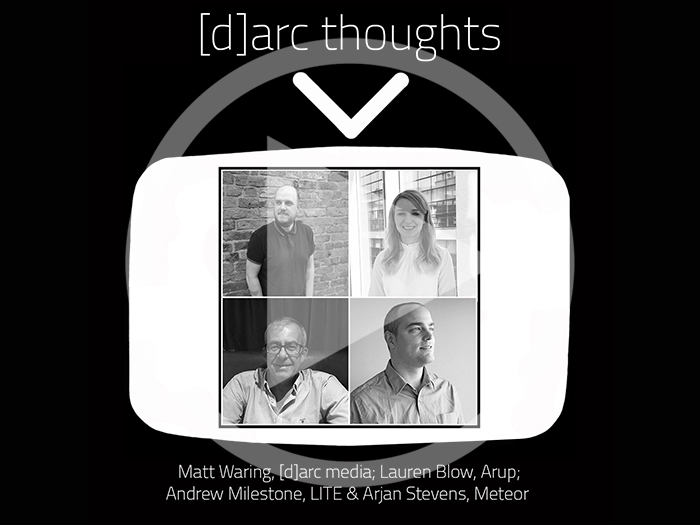
In the latest [d]arc thoughts video, arc editor Matt Waring sits down with Lauren Blow of Arup, alongside LITE's Andrew Milestone and Meteor Lighting's Arjan Stevens to discuss the new partnership between LITE and Meteor, as well as some recent lighting projects from the two manufacturers.
Lauren discusses Arup's work on Liverpool's Royal Liver Building, in which the lighting designers worked with LITE in illuminating the landmark building, while Arjan offers an insight into Meteor's work on the amazing Amazon Spheres in Seattle, USA.
Photography:
Royal Liver Building images courtesy of Arup
Amazon Spheres images & footage courtesy of Meteor Lighting
Video edited by Matt Waring
Music from bensound.com
www.arup.com
www.lite-ltd.co.uk
www.meteor-lighting.com
IALD Webinar: Covid-19 - Three Months and Counting

It's been three months since a state of emergency was declared in the US because of the Covid-19 pandemic, yet questions still remain about how our work will be impacted, move forward and transform.
Barbara Horton, President and CEO of HLB Lighting Design, and former IALD President David Ghatan, President of CM Kling + Associates, offer some insights on the pandemic, discussing the tactics they put in place back in March and April, what worked and what they had to change. They also discuss what returning to the office looks like for their firms, and how they are planning to tackle that return.
Video courtesy of IALD.
MSLD: The Future of Live Events

Moderated by Emma Cogswell of the IALD, a panel of experts discuss their thoughts on how live events in the lighting industry will look in the future, following Covid-19. The panel includes Marcus Steffen, founder of MSLD, Paul Shoosmith of Enigma Lighting, Paul James, Managing Director of [d]arc media, and Eve Gaut, founder of Parrot PR and Marketing.
Jason Bruges Studio: Archive & Process Part 1

Jason Bruges has been delving into his studio's archive to rediscover some of its most intriguing experiments and prototypes. He has unearthed digital water lilies with their own underwater ecosystem and kinetic bubbles inspired by the mechanics of extendable mops.
In this 30 minute talk, Bruges takes viewers through some quirky moments and inspiring revelations that have defined the Studio's trajectory.
IALD Webinar: Circular Economy - How to Make it Work for Lighting Designers

The IALD hosts a panel discussion on various aspects of circular economy in lighting. Johan Moritz, lighting designer at the City of Malmö, Sweden, Carla Wilkins, Founding Partner of Lichtvision Design, and Alberto Portolani, CEO at Neri North America share insights, experiences and concrete examples about what it takes to make a circular economy work in the lighting sector.
Video courtesy of IALD.

